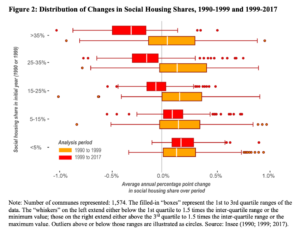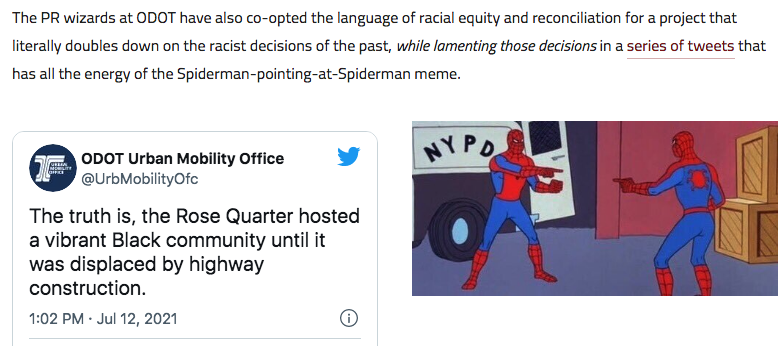What City Observatory did this week
The cost of Oregon DOT’s Rose Quarter project has nearly tripled to $1.25 billion. Just four years ago, the Oregon Department of transportation sold its mile-and-a-half long I-5 freeway widening project through Portland as costing a mere $450 million. Earlier this month, it revealed new cost estimates that show the project will cost almost triple that amount (as much as $1.25 billion). And that’s before any payment of interest on the borrowing that will be required to move the project forward, much less the cost of building housing and rebuilding schools promised as a way of mitigating the damage the freeway has done to the historically Black Albina neighborhood. Massive cost overruns are a regular feature of ODOT projects, which have routinely posted final costs 2 to 3 times the estimates floated when they were approved. Just as the agency famously dynamited a whale on an Oregon beach in 1970, this is another thing that’s blowing up in the agency’s—and taxpayer’s—faces.

Must read
1. The chain reaction of building luxury apartments. Often times, the sight of new luxury apartments leads to accusations of gentrification and rent increases. Advocates for affordable housing typically challenge this construction because they believe it only helps the wealthy. Full Stack Economics’ Timothy Lee refutes that argument and highlights research from Finland and the USA to show the comprehensive impact of luxury apartments on the overall housing market. Last month, three Finnish economists published a research paper that showcased a chain reaction from high-end apartment construction that fall across all income levels. The economists wrote, “For each 100 new, centrally located market-rate units, roughly 60 units are created in the bottom half of neighborhood income distribution through vacancies.” The new construction led to affordable housing options for rich and poor renters. In America, the results from research by economist Evan Mast prove to be similar. Chain reactions occur when new apartments are built. In this piece, the author emphasizes the positive impacts of construction, regardless of its status. When new luxury apartments are constructed, older buildings receive vacancies. The more new buildings being constructed means that older buildings will be “filtered down” to lower income tiers at quicker rates. Lee argues that the goals of developers and affordable housing advocates do not conflict like it may seem. More housing is good housing – even the luxury high rises.
2. Half a million public EV chargers is not the answer. The discourse on electric vehicles has been all the rage recently, particularly with President Biden’s goal of 50% EV sales by 2030. Just last week, the New York Times published an article announcing the US was in need of hundreds of thousands more public chargers. They argued that in order to make the adoption of EV feasible, fast public chargers would need to be placed across the nation (similarly to gas pumps). However, Vice’s Aaron Gordon does not agree. In this article, the author refutes that a lack of public chargers is a major barrier to the EV industry. Instead, he challenges readers to chance their concepts of an electric vehicle. While a normal car needs a gas pump, an electric vehicle does not need a public charging station to drive where it needs. Gordon explains,
“Most EV owners charge their cars like their phones, plugging it in overnight and having a full charge that lasts all day or more in the morning. In fact, a car charge will last much longer than your phone, on average. You’ll probably use a public charger much less often than you plug in your phone away from home.”
With the ability to charge at home, an electric vehicle eliminates the consistent need for public refuel centers. Gordon writes a thorough explanation for why adding half a million public EV chargers like the New York Times suggested would be unsustainable, expensive, and wasteful. The author asserts that “the path to a better, greener future is actually far more achievable than one might think or experts are advising.” The future of electric cars is viable. Adding unneeded infrastructure will only make this future harder to achieve.
3. The disappearance of long commute times in the Seattle area. The rise of remote work as a result of the COVID-19 pandemic has lead to drastic changes in people’s travel patterns. What length of commutes have been altered the most due to remote work? The Seattle Times’ columnist Gene Balk uses Nielsen data to explore the changes in the work commutes of Seattleites. Balk found that the number of people who did not commute more than doubled from pre-pandemic life. Breaking down the data by commute time showed a compelling relationship. Nearly 250,000 workers who had commutes over 20 minutes no longer traveled to work while there was a slight increase of workers commuting in under than 20 minutes. In particular, there was a 34% decline among 30-59 minute commutes. Remote work environments eliminated the longer commutes at a staggering level. Galk compared these results to occupational status to find a slight correlation. According to the data, a higher proportion of white collar workers lived more than 20 minutes away from their office. These workers were also more than twice as likely to work remotely compared to a blue collar occupation. Remote work changed the lives of many throughout the past year, and for nearly a quarter of a million in the Seattle area, it terminated the long commutes.
New Knowledge
France’s SRU Law and its Potential in the US. At the beginning of the century, France took a major leap in combating the economic segregation in its housing. In December 2000, the Los relative à la Solidarité et au renouvellement urbains (SRU law) passed, jumpstarting a redistribution of affordable housing more evenly across all communities in French metropolitan areas. In 2013, the law was strengthened, mandating that urban metro areas reserve 25 percent of housing stock to social housing by 2025. (Unlike inclusionary housing requirements in the US that require private developers to set aside privately built units as affordable housing, the SRU law applies to the construction of social housing, paid for directly with public funds). Dr. Yonah Freemark recently published an evaluation of the law’s effectiveness in France and tested the applicability of this housing initiative in the United States.
In his study, Dr. Freemark finds that the law led to a more equal distribution of subsidized housing in French urban areas. In particular, the SRU law was effective in opening up neighborhoods that had historically excluded low-income housing. In the French cities with the lowest share of social housing, the number of these affordable units increased from 626 in 1999 to 4,737 in 2017. Wealthier, lower-affordability communities saw significant improvement in their shares of social housing, which highlights the law’s success. Segregation by income across the country decreased as a result of the SRU law. While Freemark finds that France’s goal to have 25 percent social housing by 2025 is unlikely to be accomplished, the SRU law has shown its ability to impact the structure of urban housing markets.
The study then examines the possibility for a similar fair-share housing act to be implemented in American urban areas. Freemark compares France’s housing distribution to the state of Connecticut. What he finds – Connecticut’s affordable housing stock is significantly lower in urban areas and its distribution statewide is severely less evenly among metropolitan areas compared to France. Freemark claims that the public subsidized, affordable housing in Connecticut is more inequitably distributed than France ever experienced. This highlights major room for improvement that states like Connecticut could have by implementing similar programs to the SRU law. While there are clear limitations, Freemark asserts that there is potential for programs that could benefit thousands of American families. France’s fair-share SRU law has been effective at creating more equitable housing across the country, and it is a model that could aid low and moderate-income families in the United States as well.
In the News
Strongtowns has a great article profiling freeway fights across the country, plaintively asking why state DOT’s are planning like its 1961, instead of climate crisis 2021. They focus a spotlight on City Observatory’s coverage of Portland’s proposed Rose Quarter Freeway widening project, calling out the cynical woke-washing of the project by the Oregon Department of Transportation:




